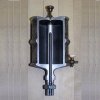KeithB
Resident Half Fast Machinist
I've been asked several times about my avatar, i.e. what is it? Rather than just give the answer I thought I would make a little contest out of it. If you can guess what it is I will give you a specially made wrench that makes it real easy to remove/replace the sizing die retention nut on Lyman 450/4500 units (7/8") or RCBS LAMs (15/16"). Winners choice. The photos are of the Mk I version, the newest ones are a little shorter. There is also a rod that comes with unit for turning nut. The O ring holds it in place in the ram. The epoxied-in ceramic magnet holds the nut in place up against a square face. Makes it easy, especially on the Lymans, to get the nut started square and not cross threaded.
Here's the rules.
First post with the correct name of the item and the inventor wins the wrench. If nobody gets it right in a few days I will start offering hints.
The item is a cutaway that I made in the school shop while I was professoring.
Hint #1: It was patented before 1900.
My avatar. What is it?


Here's the rules.
First post with the correct name of the item and the inventor wins the wrench. If nobody gets it right in a few days I will start offering hints.
The item is a cutaway that I made in the school shop while I was professoring.
Hint #1: It was patented before 1900.
My avatar. What is it?

